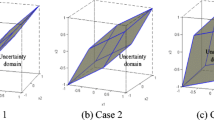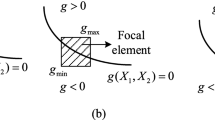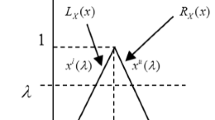Abstract
Sensitivity analysis for the quantified uncertainty in evidence theory is developed. In reliability quantification, classical probabilistic analysis has been a popular approach in many engineering disciplines. However, when we cannot obtain sufficient data to construct probability distributions in a large-complex system, the classical probability methodology may not be appropriate to quantify the uncertainty. Evidence theory, also called Dempster–Shafer Theory, has the potential to quantify aleatory (random) and epistemic (subjective) uncertainties because it can directly handle insufficient data and incomplete knowledge situations. In this paper, interval information is assumed for the best representation of imprecise information, and the sensitivity analysis of plausibility in evidence theory is analytically derived with respect to expert opinions and structural parameters. The results from the sensitivity analysis are expected to be very useful in finding the major contributors for quantified uncertainty and also in redesigning the structural system for risk minimization.
Similar content being viewed by others
References
Arora JS (1989) Introduction to optimum design. McGraw-Hill, New York
Bae H-R, Grandhi RV, Canfield RA (2003) Uncertainty quantification of structural response using evidence theory. AIAA J 41(10):2062–2068
Dempster AP, Laird NM, Rubin DB (1977) Maximum likelihood from incomplete data via the EM algorithm. J Stat Soc 39:1–38
Dong W, Shah H (1987) Vertex method for computing functions on fuzzy variables. Fuzzy Sets Syst 24:65–78
Elishakoff I (1999) Whys and hows of uncertainty modelling: probability, fuzziness and anti-optimization. Springer, Berlin Heidelberg New York
Li C, Rao SS (1998) A modified Dempster–Shafer theory for multicriteria optimization. Eng Optim 30:177–201
Oberkampf WL, Helton JC, Sentz K (2001) Mathematical representation of uncertainty. Proceedings of the 41st AIAA/ASME/ASCE/AHS/ASC structures, structural dynamics and materials conference, AIAA-2001-1645, Seattle, 16–19 April 2001
Savage LJ (1972) The foundations of statistics. Dover, New York
Sentz K, Ferson S (2002) Combination of evidence in Dempster–Shafer theory. Report SAND2002-0835, Sandia National Laboratories, Albuquerque
Shafer G (1976) A mathematical theory of evidence. Princeton University Press, Princeton
Walpole RE (1998) Probability and statistics for engineers and scientists. Prentice Hall, Upper Saddle River
Yager RR (1987) On the Dempster–Shafer framework and new combination rules. Info Sci 41:93–137
Yager RR, Kacprzyk J, Fedrizzi M (1994) Advances in the Dempster–Shafer theory of evidence. Wiley, New York
Zadeh L (1965) Fuzzy sets. Inf Control 8:338–353
Zadeh L (1984) Review of Shafer's a mathematical theory of evidence. Artif Intell Mag 5:81–83
Author information
Authors and Affiliations
Corresponding author
Rights and permissions
About this article
Cite this article
Bae, HR., Grandhi, R.V. & Canfield, R.A. Sensitivity analysis of structural response uncertainty propagation using evidence theory. Struct Multidisc Optim 31, 270–279 (2006). https://doi.org/10.1007/s00158-006-0606-9
Received:
Revised:
Published:
Issue Date:
DOI: https://doi.org/10.1007/s00158-006-0606-9




